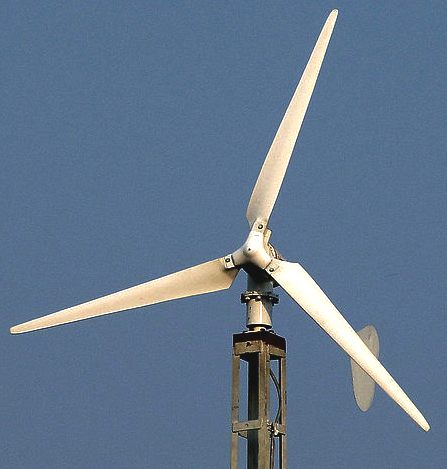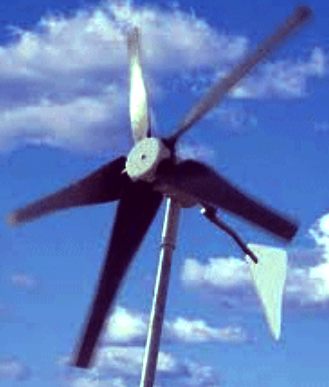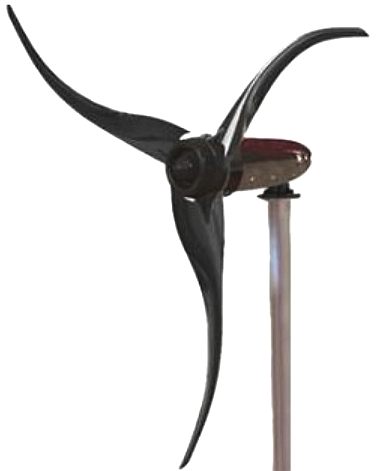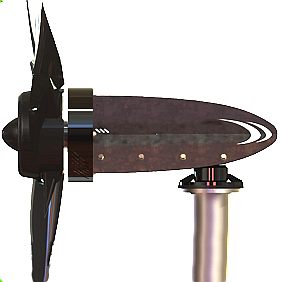|
WIND TURBINE GENERATORS
|
||||||||||||||||||||||||||||||||||||
|
Why have wind generators when you have photovoltaic panels?
We need to get as much power from nature as possible for SolarNavigator. If the ship is being crewed, we need power for lighting, toilers, showers, cooking and navigation instruments. If the ship is in autonomous mode, such as for surveying, we need power for computing, navigation sensors and data uploads.
The sun provides serious power for our batteries and to drive the traction motors directly. When the sun is not shining, very often the wind is blowing. If we did not include wind turbines to generate electricity for the onboard systems, then we'd have to include extra PV panel space, or, run the ship slower. In addition, wind blows at night when it is dark, so the instrumentation can work 24 hours a day - without straining battery reserves.
Wind energy is a natural resource and ultimately derives from the sun irradiating the planet. We don't want sails onboard an all electric ship. Sails would in any event cloud the solar array, whereas, we can raise and lower the boom of our wind turbines. During the day they might be held at half mast, as per the drawing below. At night they can be raised higher into the air stream without clouding the solar arrays.
STORMS
There are times when there is too much wind. Too much wind for too long could easily burn out the onboard turbines. For this reason, as much as the need to raise the turbines as high as possible into the air stream, the turbines are mounted on a moveable boom.
Turbines are often mounted on a tower to raise them above any nearby obstacles. One rule of thumb is that turbines should be at least 30 ft (9.1 m) higher than anything within 500 ft (150 m).
A typical 1Kw domestic three blade and five blade turbines
LIKELY OUTPUT - BETZ'S LAW
A quantitative measure of the wind energy available at any location is called the Wind Power Density (WPD) It is a calculation of the mean annual power available per square meter of swept area of a turbine, and is tabulated for different heights above ground. Calculation of wind power density includes the effect of wind velocity and air density. Color-coded maps are prepared for a particular area described, for example, as "Mean Annual Power Density at 50 Metres". In the United States, the results of the above calculation are included in an index developed by the National Renewable Energy Laboratory and referred to as "NREL CLASS". The larger the WPD calculation, the higher it is rated by class. Classes range from Class 1 (200 watts per square metre or less at 50 m altitude) to Class 7 (800 to 2000 watts per square m). Commercial wind farms generally are sited in Class 3 or higher areas, although isolated points in an otherwise Class 1 area may be practical to exploit.
By
way of example, let us take 100 watts per square meter as a realistic target
for SolarNavigator. Multiply the diameter of the blade: 3.142 x 1.5 x
1.5 = 7.07 m2. Multiply x 4 (turbines) = 28.28 m2 swept
area. Multiplied by 100watts = 2.828 Kw/hr. Or, multiplied by 200w =
5.656Kw/hr for a Class 1 area. Such turbines typically weigh 60Kg each. Thus
the boom and and 4 turbines and hydraulics should come in under 500Kg.
Betz's law calculates the maximum power that can be extracted from the wind, independent of the design of a wind turbine in open flow. It was published in 1919, by the German physicist Albert Betz. The law is derived from the principles of conservation of mass and momentum of the air stream flowing through an idealized "actuator disk" that extracts energy from the wind stream. According to Betz's law, no turbine can capture more than 16/27 (59.3 percent) of the kinetic energy in wind. The factor 16/27 (0.593) is known as Betz's coefficient. Practical utility-scale wind turbines achieve at peak 75% to 80% of the Betz limit.
The Betz limit is based on an open disk actuator; if a diffuser is used to collect additional wind flow and direct it through the turbine, more energy can be extracted. However, such shrouded turbines are costly to build in utility-scale units because of the extra structure required.
The Betz law means that wind turbines can never be better than 59.3% efficient. The law can be simply explained by considering that if all of the energy coming from wind movement into the turbine were converted into useful energy then the wind speed afterwards would be zero. But, if the wind stopped moving at the exit of the turbine, then no more fresh wind could get in - it would be blocked. In order to keep the wind moving through the turbine, to keep getting energy, there has to be some wind movement on the outside with energy left in it. There must be a 'sweet spot' somewhere - and there is, the Betz limit at 59.3%. It's better to have 60% of something than nothing at all.
A 2Kw three 3 meter diameter 3 blade turbine
DESCRIPTION
A wind turbine is a device that converts kinetic energy from the wind, also called wind energy, into mechanical energy; a process known as wind power. If the mechanical energy is used to produce electricity, the device may be called a wind turbine or wind generator. Similarly, it may be called wind charger when it is used to charge batteries.
If the mechanical energy is used to drive machinery, such as for grinding grain or pumping water, the device is called a windmill or wind pump.
|
||||||||||||||||||||||||||||||||||||
|
This website is copyright © 2013 Electrick Publications. All rights reserved. The bird logo and names Solar Navigator and Blueplanet Ecostar are trademarks ™. The Blueplanet vehicle configuration is registered ®. All other trademarks hereby acknowledged and please note that this project should not be confused with the Australian: 'World Solar Challenge'™which is a superb road vehicle endurance race from Darwin to Adelaide. Max Energy Limited is an educational charity working hard to promote world peace.
|




